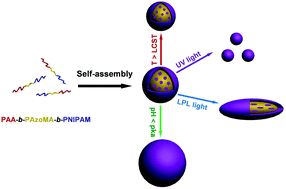Self-assembly and multi-stimuli responsive behavior of PAA-b-PAzoMA-b-PNIPAM triblock copolymers†
Abstract
In this work, a triblock copolymer poly(acrylic acid)-block-poly[6-(4-methoxy-azobenzene-4′-oxy) hexylmethacrylate]-block-poly(N-isopropylacrylamide) (PAA-b-PAzoMA-b-PNIPAM) containing pH, photo and temperature sensitive groups was synthesized through three-step RAFT polymerization. By tuning the solvents, the copolymer could self-assemble into spherical micelles or vesicles with multi-stimuli responsiveness. Either the micelles or the vesicles underwent obvious size decreases when the temperature was above the LCST of PNIPAM, and size increases when the pH value was below the pKa of PAA without obvious morphology changes. In addition, under UV irradiation, the micelles disrupted into much smaller particles whereas the vesicles transformed into micelles with an apparent size decrease on account of trans-to-cis isomerization of the azobenzene moieties. Upon irradiation by linear polarized light, the micelles were elongated into spindles and short rods. Furthermore, the photo-isomerization rate of the azobenzene moiety could be modulated by pH and temperature. The multi-stimuli responsive properties of PAA-b-PAzoMA-b-PNIPAM will further expand the potential application of azobenzene copolymers in smart materials.



 Please wait while we load your content...
Please wait while we load your content...